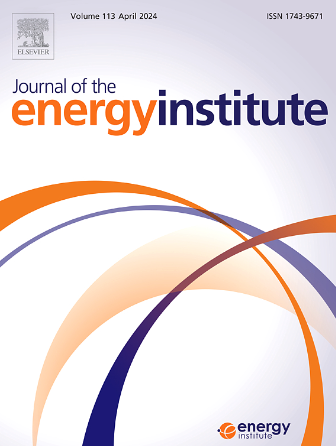耐焦掺杂钴/介孔氧化铝催化剂在甲烷干转化过程中制氢
IF 5.6
2区 工程技术
Q2 ENERGY & FUELS
引用次数: 0
摘要
甲烷的干重整,DRM被广泛认为是一种有前途的H2能源替代化石燃料的途径。在化学计量DRM进料组成和650 ~ 750℃条件下,研究了镨掺杂(0 ~ 7 wt %)对介孔氧化铝(MA)分散Co催化剂性能和抗结焦性能的促进作用。Pr的促进使Co3O4晶粒尺寸从16.8 nm减小到7.8 nm,其中5Pr10Co/MA的Co3O4晶粒尺寸最小。Pr的加入使碱基总浓度由66.8 μmol CO2 gcat−1提高到169.7 μmol CO2 gcat−1。在Pr促进的催化剂(1% ~ 5% Pr)上,由于提高了碱基浓度和CO2的吸附,CH4的转化率稳定且随时间变化。值得注意的是,在700°C时,5Pr10Co/MA的CH4转化率最高(90.91%),CO2转化率最高(82.13%),由于Co3O4晶粒尺寸、氧空位和氧化还原属性最小,5Pr10Co/MA的碳沉积率最低(0.87%),碳生成率最低(2.42 × 10−5 gcarbongcat−1 min−1)。当温度从650℃升高到750℃时,5Pr10Co/MA的H2产率从52.52%提高到87.94%。本文还阐述了氧化还原PrO2/Pr2O3对两步抑制焦炭的机理。本文章由计算机程序翻译,如有差异,请以英文原文为准。

Hydrogen production from methane dry reforming on coke-resistant Pr-doped Co/mesoporous alumina catalysts
Dry reforming of methane, DRM is largely recognized as a promising route for generating H2 energy to substitute fossil fuels. In this work, the promotional effect of praseodymium dopant (0-7 wt %) on the performance and coking resistance of mesoporous alumina (MA)-dispersed Co catalysts was investigated at a stoichiometric DRM feed composition and 650–750 °C. Pr promotion considerably reduced Co3O4 crystal dimension from 16.8 to 7.8 nm and 5Pr10Co/MA possessed the smallest Co3O4 crystallite size. The total basic site concentration was boosted with Pr addition from 66.8 to 169.7 μmol CO2 . Stable CH4 conversion with time-on-stream was evidenced on Pr-promoted catalysts (1 %-5 %Pr) because of enhancing basic site concentration and CO2 adsorption. Notably, 5Pr10Co/MA achieved the greatest CH4 (90.91 %) and CO2 (82.13 %) conversions at 700 °C and exhibited the highest coke resistance with the least carbon deposition percentage (0.87 %) and carbon formation rate (2.42 × 10−5 min−1) owing to the smallest Co3O4 crystallite size, oxygen vacancy and redox attributes. An enhancement in H2 yield from 52.52 % to 87.94 % was evidenced on 5Pr10Co/MA with rising temperature from 650 to 750 °C. The two-step mechanism for coke suppression triggered by a redox PrO2/Pr2O3 pair was also elaborated in this study.
求助全文
通过发布文献求助,成功后即可免费获取论文全文。
去求助
来源期刊

Journal of The Energy Institute
工程技术-能源与燃料
CiteScore
10.60
自引率
5.30%
发文量
166
审稿时长
16 days
期刊介绍:
The Journal of the Energy Institute provides peer reviewed coverage of original high quality research on energy, engineering and technology.The coverage is broad and the main areas of interest include:
Combustion engineering and associated technologies; process heating; power generation; engines and propulsion; emissions and environmental pollution control; clean coal technologies; carbon abatement technologies
Emissions and environmental pollution control; safety and hazards;
Clean coal technologies; carbon abatement technologies, including carbon capture and storage, CCS;
Petroleum engineering and fuel quality, including storage and transport
Alternative energy sources; biomass utilisation and biomass conversion technologies; energy from waste, incineration and recycling
Energy conversion, energy recovery and energy efficiency; space heating, fuel cells, heat pumps and cooling systems
Energy storage
The journal''s coverage reflects changes in energy technology that result from the transition to more efficient energy production and end use together with reduced carbon emission.
 求助内容:
求助内容: 应助结果提醒方式:
应助结果提醒方式:


